Overcoming Tribal Boundaries: The Biocultural Heritage of Foraging and Cooking Wild Vegetables among Four Pathan Groups in the Gadoon Valley, NW Pakistan
Abstract
Simple Summary
Abstract
1. Introduction
- (a)
- Explore and identify the wild vegetable resources collected in the Gadoon Valley;
- (b)
- Document their seasonality and eventual occurrence in local markets, as well as the local food knowledge attached to them and their possible medicinal perceptions;
- (c)
- Cross-culturally compare the recorded traditional knowledge among the four considered Pathan groups;
- (d)
- Compare the collected data with the published wild food ethnobotanical literature in order to identify possible novel reports of wild vegetable use.
2. Material and Methods
2.1. Study Area
2.2. Socio-Demographic Details of the Informants
2.3. Brief Historical Notes of the Gadoon Valley Tribes
2.4. Overall Methodology and Data Collection
2.5. Species Documentation and Identification
2.6. Data Analysis
2.6.1. Jaccard Similarity Index
2.6.2. Use Report and Cultural Importance Indexes
3. Results and Discussion
3.1. Wild Vegetables in the Gadoon Valley
3.2. Seasonality and Market Value of Wild Vegetables
3.3. Wild Vegetables in Local Folk Cuisine and Domestic Medicine
3.4. Quantitative Analysis
3.5. Cross-Cultural Comparison among the Four Considered Pathan Tribes
4. Novelty of the Recorded Data and Future Perspectives
5. Conclusions
Author Contributions
Funding
Institutional Review Board Statement
Informed Consent Statement
Data Availability Statement
Acknowledgments
Conflicts of Interest
References
- Beluhan, S.; Ranogajec, A. Chemical composition and non-volatile components of Croatian wild edible mushrooms. Food Chem. 2011, 124, 1076–1082. [Google Scholar] [CrossRef]
- Bhatia, H.; Sharma, Y.P.; Manhas, R.K.; Kumar, K. Traditionally used wild edible plants of district Udhampur, J&K, India. J. Ethnobiol. Ethnomed. 2018, 14, 73. [Google Scholar] [CrossRef]
- Hussain, J.; Khan, F.U.; Ullah, R.; Muhammad, Z.; Rehman, N.; Shinwari, Z.K.; Khan, I.U.; Zohaib, M.; Din, I.; Hussain, S.M. Nutrient evaluation and elemental analysis of four selected medicinal plants of Khyber Pakhtunkhwa, Pakistan. Pak. J. Bot. 2011, 43, 427–434. [Google Scholar]
- Huber, F.K.; Ineichen, R.; Yang, Y.; Weckerle, C.S. Livelihood and Conservation Aspects of Non-wood Forest Product Collection in the Shaxi Valley, Southwest China. Econ. Bot. 2010, 64, 189–204. [Google Scholar] [CrossRef]
- Kleinn, C.; Yang, Y.; Weyerhäuser, H.; Stark, M. The Sustainable Harvest of Non-Timber Forest Products in China: Strategies to Balance Economic Benefits and Biodiversity Conservation; Chinese Academy of Sciences: Kunming, China, 2006. [Google Scholar]
- Khan, J.; Khan, R.; Qureshi, R.A. Ethnobotanical study of commonly used weeds of District Bannu, Khyber Pakhtunkhwa (Pakistan). J. Med. Plants Stud. 2013, 1, 1–6. [Google Scholar]
- Khan, M.; Hussain, F.; Musharaf, S. Ethnobotanical profile of Tehsil Takht-e-Nasratti, District Karak, Pakistan. J. Med. Plants Res. 2013, 7, 1636–1651. [Google Scholar]
- Wariss, H.M.; Ahmad, S.; Anjum, S.; Alam, K. Ethnobotanical studies of dicotyledonous plants of Lal Suhanra national park, Bahawalpur, Pakistan. Int. J. Sci. Res. 2014, 3, 2452–2460. [Google Scholar]
- Ahmad, K.; Weckerle, C.S.; Nazir, A. Ethnobotanical investigation of wild vegetables used among local communities in northwest Pakistan. Acta Soc. Bot. Pol. 2019, 88, 3616. [Google Scholar] [CrossRef]
- Naveed, S.; Khattak, I.; Marwat, K.B. Ethnobotanical study of important wild plants of district Swabi Khyber Pakhtunkhwa Pakistan. Pak. J. Weed Sci. Res. 2018, 24, 279–293. [Google Scholar] [CrossRef]
- Abbas, W.; Hussain, W.; Hussain, W.; Badshah, L.; Hussain, K.; Pieroni, A. Traditional wild vegetables gathered by four religious groups in Kurram District, Khyber Pakhtunkhwa, North-West Pakistan. Genet. Res. Crop Evol. 2020, 67, 1521–1536. [Google Scholar] [CrossRef]
- Abdul Aziz, M.; Ullah, Z.; Pieroni, A. Wild Food Plant Gathering among Kalasha, Yidgha, Nuristani and Khowar Speakers in Chitral, NW Pakistan. Sustainability 2020, 12, 9176. [Google Scholar] [CrossRef]
- Abbasi, A.M.; Khan, M.A.; Shah, M.H.; Shah, M.M.; Pervez, A.; Ahmad, M. Ethnobotanical appraisal and cultural values of medicinally important wild edible vegetables of Lesser Himalayas-Pakistan. J. Ethnobiol. Ethnomed. 2013, 9, 66. [Google Scholar] [CrossRef] [PubMed]
- Kang, J.; Kang, Y.; Ji, X.; Guo, Q.; Jacques, G.; Pietras, M.; Łuczaj, N.; Li, D.; Łuczaj, Ł. Wild food plants and fungi used in the mycophilous Tibetan community of Zhagana (Tewo County, Gansu, China). J. Ethnobiol. Ethnomed. 2016, 12, 21. [Google Scholar] [CrossRef]
- Kang, Y.; Łuczaj, Ł.; Kang, J.; Wang, F.; Hou, J.; Guo, Q. Wild food plants used by the Tibetans of Gongba Valley (Zhouqu county, Gansu, China). J. Ethnobiol. Ethnomed. 2014, 10, 20. [Google Scholar] [CrossRef]
- Ogle, B.M.; Tuyet, H.T.; Duyet, H.N.; Dung, N.N.X. Food, feed or medicine: The multiple functions of edible wild plants in Vietnam. Econ. Bot. 2003, 57, 103–117. [Google Scholar] [CrossRef][Green Version]
- Kang, Y.; Łuczaj, Ł.; Kang, J.; Zhang, S. Wild food plants and wild edible fungi in two valleys of the Qinling Mountains (Shaanxi, central China). J. Ethnobiol. Ethnomed. 2013, 9, 26. [Google Scholar] [CrossRef]
- Munir, H.; Ejaz, Q. Global water crisis and future food security in an era of climate change. Food Policy 2010, 35, 365–377. [Google Scholar] [CrossRef]
- Sher, Z.; Hussain, F.; Saleem, M. Macro-mineral status at three phenological stages of some range shrubs of Gadoon hills, district Swabi, Khyber Pakhtunkhwa, Pakistan. Pak. J. Bot. 2012, 44, 711–716. [Google Scholar]
- Shad, A.A.; Shah, H.U.; Bakht, J. Ethnobotanical assessment and nutritive potential of wild food plants. J. Anim. Plant Sci. 2013, 23, 92–99. [Google Scholar]
- Pieroni, A.; Houlihan, L.; Ansari, N.; Hussain, B.; Aslam, S. Medicinal perceptions of vegetables traditionally consumed by South-Asian migrants living in Bradford, Northern England. J. Ethnopharmacol. 2007, 113, 100–110. [Google Scholar] [CrossRef]
- Berihun, T.; Molla, E. Study on the diversity and use of wild edible plants in Bullen District Northwest Ethiopia. J. Bot. 2017, 8383468. [Google Scholar] [CrossRef]
- Romeo, R.; Vita, A.; Testolin, R.; Hofer, T. Mapping the Vulnerability of Mountain Peoples to Food Insecurity; FAO: Rome, Italy, 2015. [Google Scholar]
- Ahmad, K.; Pieroni, A. Folk knowledge of wild food plants among the tribal communities of Thakht-e-Sulaiman Hills, North-West Pakistan. J. Ethnobiol. Ethnomed. 2016, 12, 17. [Google Scholar] [CrossRef] [PubMed]
- Naik, R.; Borkar, S.D.; Bhat, S.; Acharya, R. Therapeutic potential of wild edible vegetables-A. J. Ayurveda Integr. Med. Sci. 2017, 2, 85. [Google Scholar] [CrossRef][Green Version]
- Łuczaj, Ł. Changes in the utilization of wild green vegetables in Poland since the 19th century: A comparison of four ethnobotanical surveys. J. Ethnopharmacol. 2010, 128, 395–404. [Google Scholar] [CrossRef]
- Thakur, D.; Sharma, A.; Uniyal, S.K. Why they eat, what they eat: Patterns of wild edible plants consumption in a tribal area of Western Himalaya. J. Ethnobiol. Ethnomed. 2017, 13, 70. [Google Scholar] [CrossRef] [PubMed]
- FAO. Use and Potential of Wild Plants in Farm Households. FAO: Rome, 1999. Available online: http://www.fao.org/3/W8801E/w8801e00.htm (accessed on 21 May 2021).
- Ulian, T.; Diazgranados, M.; Pironon, S.; Padulosi, S.; Liu, U.; Davies, L.; Howes, M.J.R.; Borrell, J.S.; Ondo, I.; Pérez-Escobar, O.A.; et al. Unlocking plant resources to support food security and promote sustainable agriculture. Plants People Planet 2020, 2, 421–445. [Google Scholar] [CrossRef]
- Johns, T. With Bitter Herbs They Shall Eat It: Chemical Ecology and the Origins of Human Diet and Medicine; University of Arizona Press: Tucson, AZ, USA, 1990. [Google Scholar]
- Czúcz, B.; Arany, I.; Potschin-Young, M.; Bereczki, K.; Kertész, M.; Kiss, M.; Aszalós, R.; Haines-Young, R. Where concepts meet the real world: A systematic review of ecosystem service indicators and their classification using CICES. Ecosyst. Serv. 2018, 29, 145–157. [Google Scholar] [CrossRef]
- Vári, Á.; Arany, I.; Kalóczkai, Á.; Kelemen, K.; Papp, J.; Czúcz, B. Berries, greens, and medicinal herbs—mapping and assessing wild plants as an ecosystem service in Transylvania (Romania). J. Ethnobiol. Ethnomed. 2020, 16, 13. [Google Scholar] [CrossRef] [PubMed]
- Yeşil, Y.; Çelik, M.; Yılmaz, B. Wild edible plants in Yeşilli (Mardin-Turkey), a multicultural area. J. Ethnobiol. Ethnomed. 2019, 15, 52. [Google Scholar] [CrossRef]
- Ali, A.; Iqbal, S.; Awan, M.S. Wastewater Analysis of Gadoon-Amazai Industrial Zone. J. Ind. Saf. Eng. 2019, 2, 43–47. [Google Scholar]
- Ali, S.I.; Qaisar, M. (Eds.) Flora of Pakistan; Pakistan Agricultural Research Council: Islamabad, Pakistan, 1995–2009.
- Nasir, E.; Ali, S.I. (Eds.) Flora of West Pakistan; Department of Botany, University of Karachi: Karachi, Pakistan, 1971–1995.
- Shah, S.; Khan, S.; Sulaiman, S.; Muhammad, M.; Badshah, L.; Bussmann, R.W.; Hussain, W. Quantitative study on medicinal plants traded in selected herbal markets of Khyber Pakhtunkhwa, Pakistan. Ethnobot. Res. Appl. 2020, 20, 1–36. [Google Scholar]
- Kaur, M.; Vashistha, B.D. Cultural importance indices of some useful plants of Ambala District, Haryana, India. Acad. J. Med. Plants. 2018, 6, 127–132. [Google Scholar] [CrossRef]
- Najem, M.; Ibijbijen, J.; Nassiri, L. Quantitative ethnobotanical study of toxic plants used in the traditional pharmacopoeia of the Central Middle Atlas-Morocco. Ethnobot. Res. Appl. 2019, 18, 1–17. [Google Scholar] [CrossRef][Green Version]
- Pardo-de-Santayana, M.; Tardío, J.; Blanco, E.; Carvalho, A.M.; Lastra, J.J.; San Miguel, E.; Morales, R. Traditional knowledge of wild edible plants used in the northwest of the Iberian Peninsula (Spain and Portugal): A comparative study. J. Ethnobiol. Ethnomed. 2007, 3, 1–11. [Google Scholar] [CrossRef]
- Pieroni, A. Evaluation of the cultural significance of wild food botanicals traditionally consumed in Northwestern Tuscany, Italy. J. Ethnobiol. 2001, 21, 89–104. [Google Scholar]
- Pieroni, A.; Sõukand, R. Ethnic and religious affiliations affect traditional wild plant foraging in Central Azerbaijan. Genet. Res. Crop. Evol. 2019, 66, 1495–1513. [Google Scholar] [CrossRef]
- Pieroni, A.; Soukand, R.; Bussmann, R.W. The Inextricable Link Between Food and Linguistic Diversity: Wild Food Plants among Diverse Minorities in Northeast Georgia, Caucasus. Econ. Bot. 2020, 74, 379–397. [Google Scholar] [CrossRef]
- Dogan, Y.; Baslar, S.; Ay, G.; Mert, H.H. The use of wild edible plants in western and central Anatolia (Turkey). Econ. Bot. 2004, 58, 684–690. [Google Scholar] [CrossRef]
- You-Kai, X.; Guo-Da, T.; Hong-Mao, L.; Kang-La, Y.; Xiang-Sheng, D. Wild vegetable resources and market survey in Xishuangbanna, Southwest China. Econ. Bot. 2004, 58, 647–667. [Google Scholar] [CrossRef]
- Agea, J.G.; Kimondo, J.M.; Okia, C.A.; Abohassan, R.A.A.; Obua, J.; Hall, J.; Teklehaimanot, Z. Contribution of wild and semi-wild food plants to overall household diet in Bunyoro-Kitara Kingdom, Uganda. Agric. J. 2011, 6, 134–144. [Google Scholar] [CrossRef]
- Agea, J.G.; Okia, C.A.; Abohassan, R.A.A.; Kimondo, J.M.; Obua, J.; Hall, J.; Teklehaimanot, Z. Wild and Semi-Wild Food Plants of Bunyoro-Kitara Kingdom of Uganda: Growth forms, collection niches, parts consumed, consumption patterns, main gatherers and consumers. Environ. Res. J. 2013, 5, 74–86. [Google Scholar] [CrossRef]
- Tareen, N.M.; Saeed-ur-Rehman, M.A.; Shinwari, Z.K.; Bibi, T.A.H.I.R.A. Ethnomedicinal utilization of wild edible vegetables in district Harnai of Balochistan Province-Pakistan. Pak. J. Bot. 2016, 48, 1159–1171. [Google Scholar]
- Ojelel, S.; Mucunguzi, P.; Katuura, E.; Kakudidi, E.K.; Namaganda, M.; Kalema, J. Wild edible plants used by communities in and around selected forest reserves of Teso-Karamoja region, Uganda. J. Ethnobiol. Ethnomed. 2019, 15, 3. [Google Scholar] [CrossRef] [PubMed]
- Fernández-Giménez, M.E.; Estaque, F.F. Pyrenean pastoralists’ ecological knowledge: Documentation and application to natural resource management and adaptation. Hum. Ecol. 2012, 40, 287–300. [Google Scholar] [CrossRef]
- Ghimire, S.K.; Aumeeruddy-Thomas, Y. Ethnobotanical classification and plant nomenclature system of high altitude agropastoralists in Dolpo, Nepal. Botanica Orientalis. J. Plant. Sci. 2009, 6, 56–68. [Google Scholar] [CrossRef]
- Oteros-Rozas, E.; Ontillera-Sánchez, R.; Sanosa, P.; Gómez-Baggethun, E.; Reyes-García, V.; González, J.A. Traditional ecological knowledge among transhumant pastoralists in Mediterranean Spain. Ecol. Soc. 2013, 18, 33. [Google Scholar] [CrossRef]
- Dong, S.; Wen, L.; Liu, S.; Zhang, X.; Lassoie, J.P.; Yi, S.; Li, X.; Li, J.; Li, Y. Vulnerability of worldwide pastoralism to global changes and interdisciplinary strategies for sustainable pastoralism. Ecol. Soc. 2011, 16. [Google Scholar] [CrossRef]
- Aworh, O.C. Promoting food security and enhancing Nigeria’s small farmers’ income through value-added processing of lesser-known and under-utilized indigenous fruits and vegetables. Food Res. Int. 2015, 76, 986–991. [Google Scholar] [CrossRef]
- Shah, S.M.; Amin, M.; Gul, B.; Begum, M. Ethnoecological, Elemental, and Phytochemical Evaluation of Five Plant Species of Lamiaceae in Peshawar, Pakistan. Scientifica 2020, 2982934. [Google Scholar] [CrossRef]
- Shah, S.; Khan, S.; Shah, S.M.; Khan, S.; Khatak, L.; Rukh, G. Ethnoecological appraisal, mineral and phytochemical analysis of five species of Myrtaceae in University Campus, Peshawar, Pakistan. Pure Appl. Biol. 2020, 10, 244–253. [Google Scholar] [CrossRef]
- Shah, S.; Khan, S.; Bussmann, R.W.; Ali, M.; Hussain, D.; Hussain, W. Quantitative ethnobotanical study of Indigenous knowledge on medicinal plants used by the tribal communities of Gokand Valley, District Buner, Khyber Pakhtunkhwa, Pakistan. Plants 2020, 9, 1001. [Google Scholar] [CrossRef]
- Etkin, N.L. Local knowledge of biotic diversity and its conservation in rural Hausaland, Northern Nigeria. Econ. Bot. 2002, 56, 73–88. [Google Scholar] [CrossRef]
- Abbet, C.; Mayor, R.; Roguet, D.; Spichiger, R.; Hamburger, M.; Potterat, O. Ethnobotanical survey on wild alpine food plants in Lower and Central Valais (Switzerland). J. Ethnopharmacol. 2014, 151, 624–634. [Google Scholar] [CrossRef]
- Kamalebo, H.M.; Malale, H.N.S.W.; Ndabaga, C.M.; Degreef, J.; De Kesel, A. Uses and importance of wild fungi: Traditional knowledge from the Tshopo province in the Democratic Republic of the Congo. J. Ethnobiol. Ethnomed. 2018, 14, 13. [Google Scholar] [CrossRef]
- Tardío, J.; Pardo-de-Santayana, M. Cultural importance indices: A comparative analysis based on the useful wild plants of Southern Cantabria (Northern Spain). Econ. Bot. 2008, 62, 24–39. [Google Scholar] [CrossRef]
- Hamayun, M.; Khan, S.A.; Iqbal, I.; Rehman, G.; Hayat, T.; Khan, M.A. Ethnobotanical profile of Utror and Gabral valleys, district Swat, Pakistan. Ethnobot. Leafl. 2005, 2005, 9. [Google Scholar]
- Shaheen, H.; Qureshi, R.; Qaseem, M.F.; Amjad, M.S.; Bruschi, P. The cultural importance of indices: A comparative analysis based on the useful wild plants of Noorpur Thal Punjab, Pakistan. Eur. J. Integr. Med. 2017, 12, 27–34. [Google Scholar] [CrossRef]
- Tiwari, P.C.; Joshi, B. Natural and socio-economic factors affecting food security in the Himalayas. Food Secur. 2012, 4, 195–207. [Google Scholar] [CrossRef]
- Pieroni, A.; Sõukand, R.; Amin, H.I.M.; Zahir, H.; Kukk, T. Celebrating Multi-Religious Co-Existence in Central Kurdistan: The Bio-Culturally Diverse Traditional Gathering of Wild Vegetables among Yazidis, Assyrians, and Muslim Kurds. Hum. Ecol. 2018, 46, 217–227. [Google Scholar] [CrossRef]
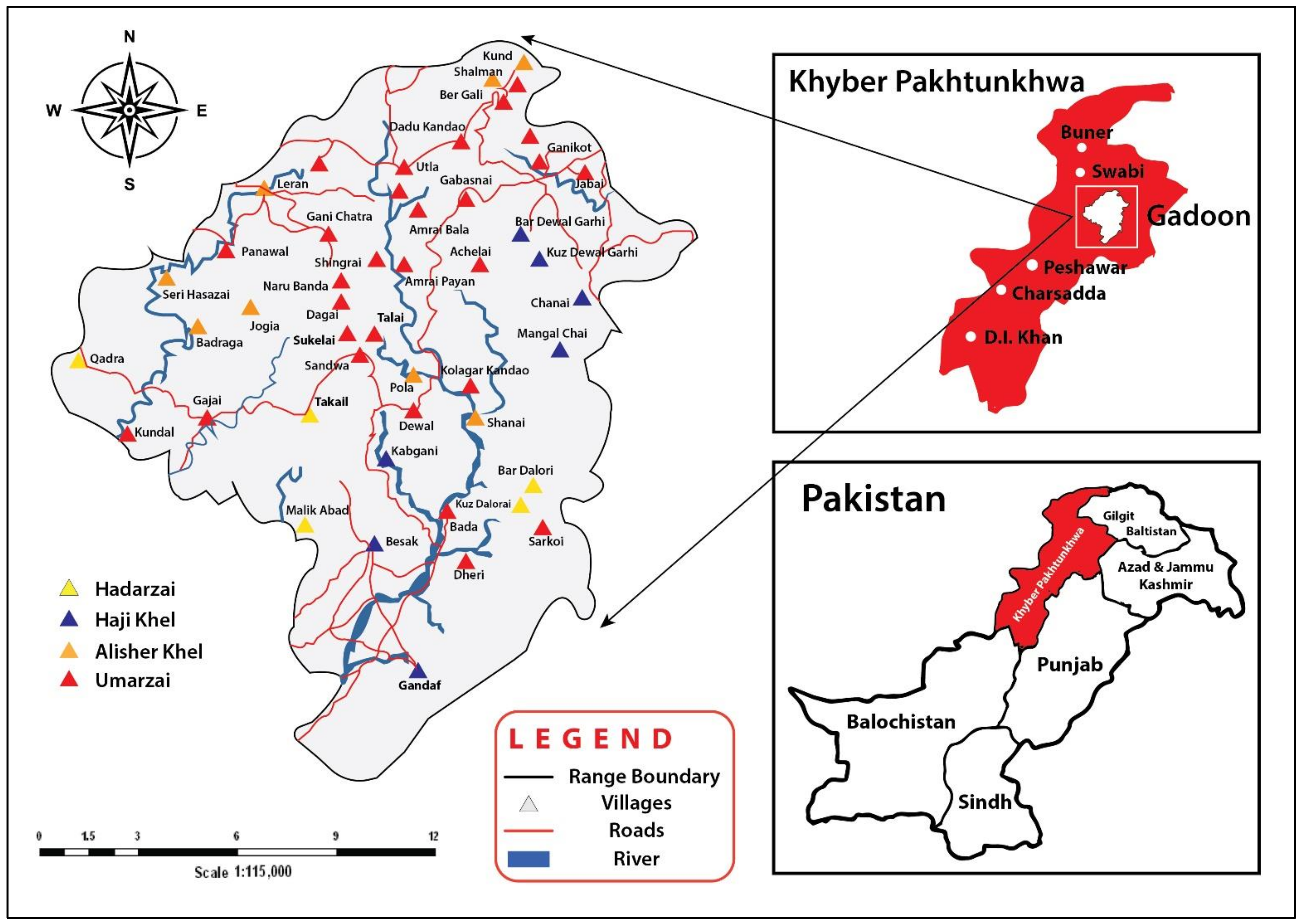

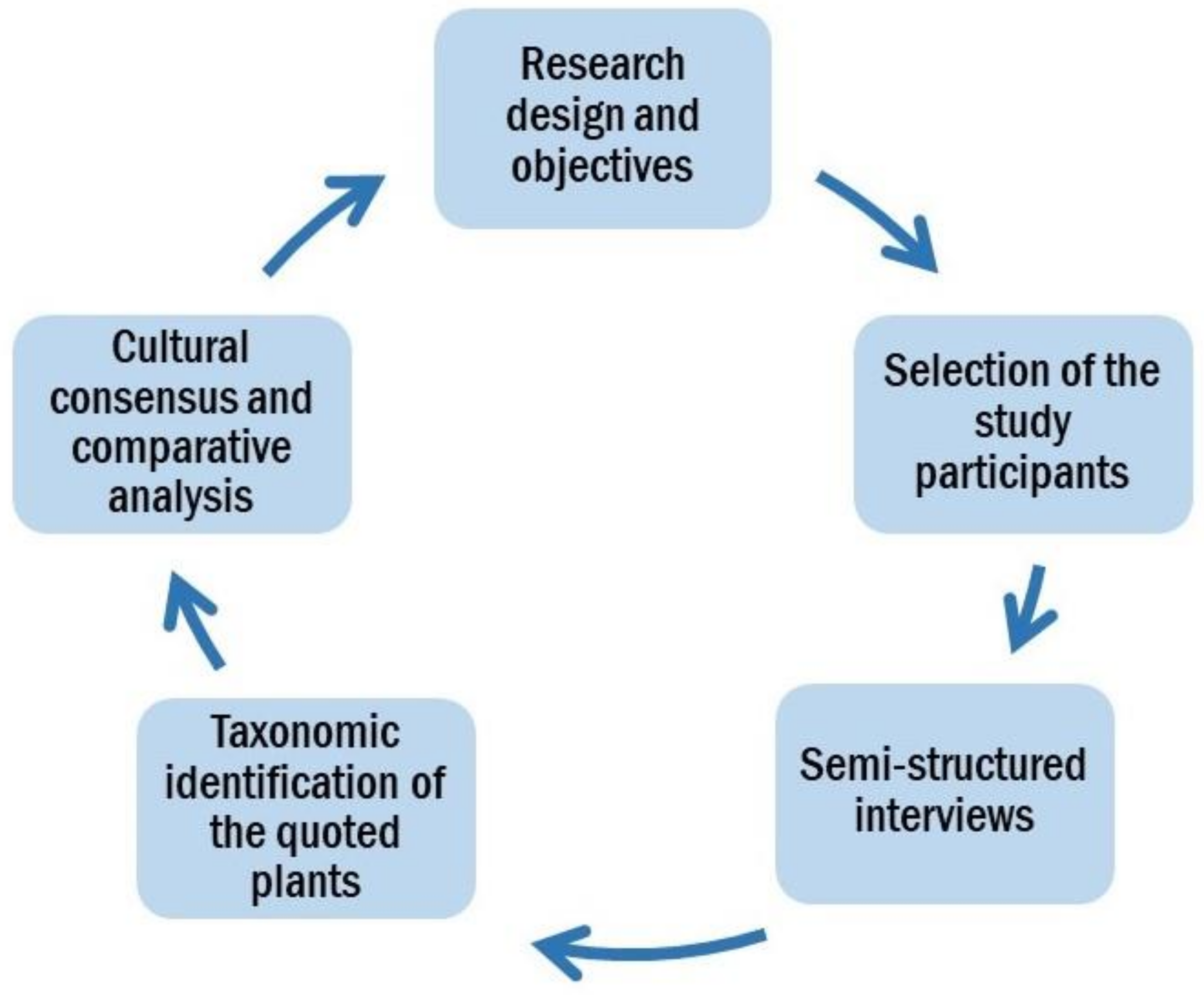



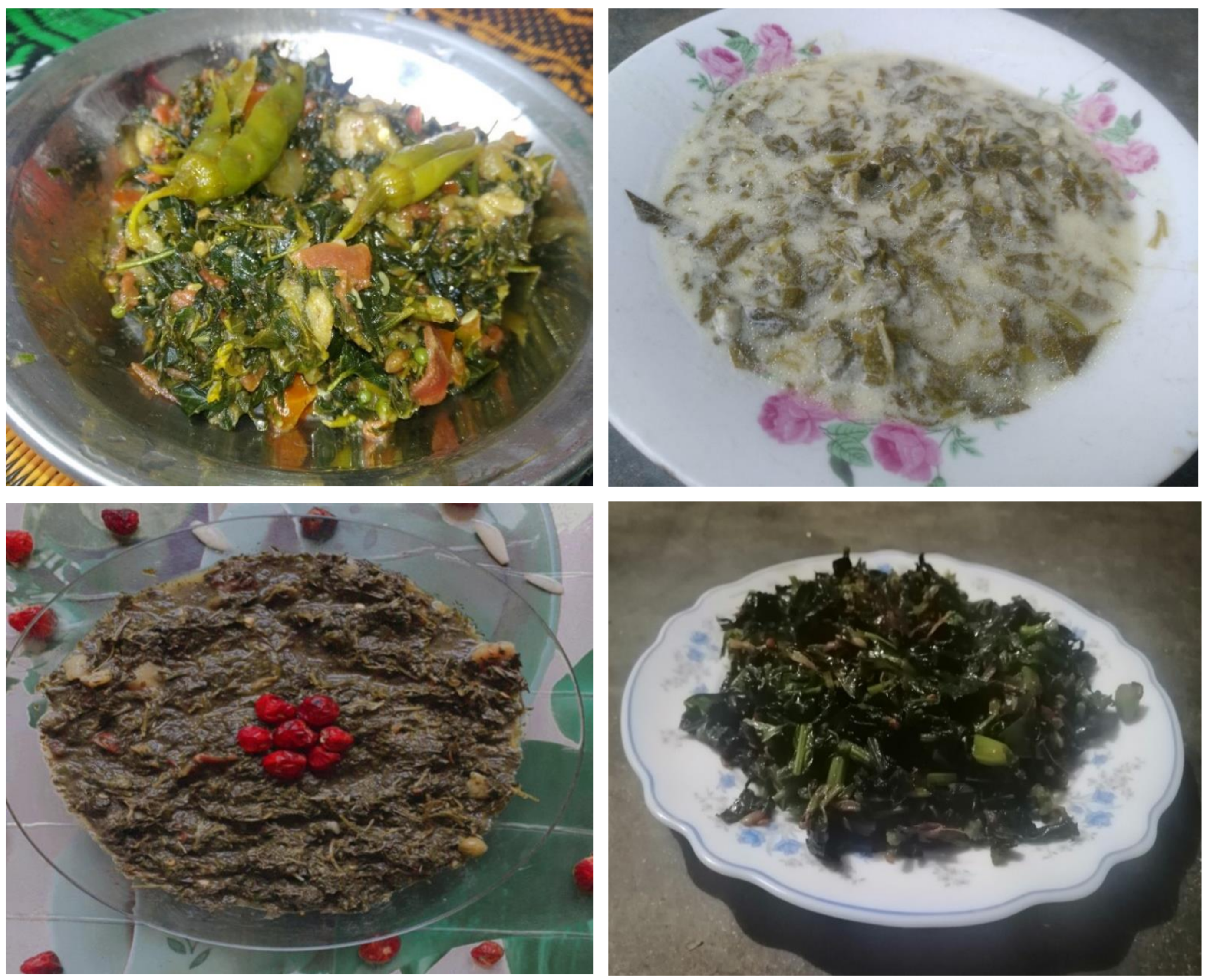

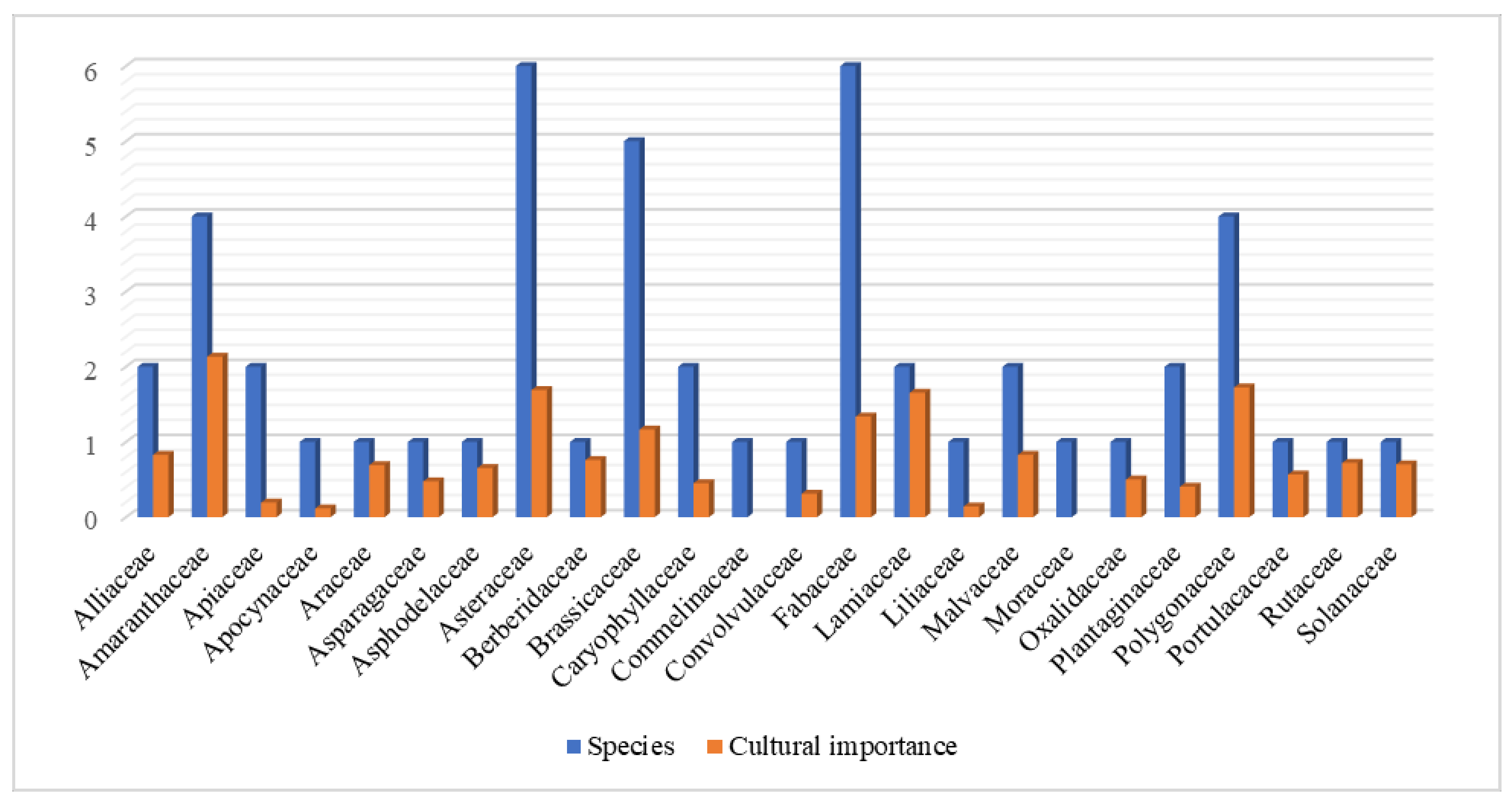
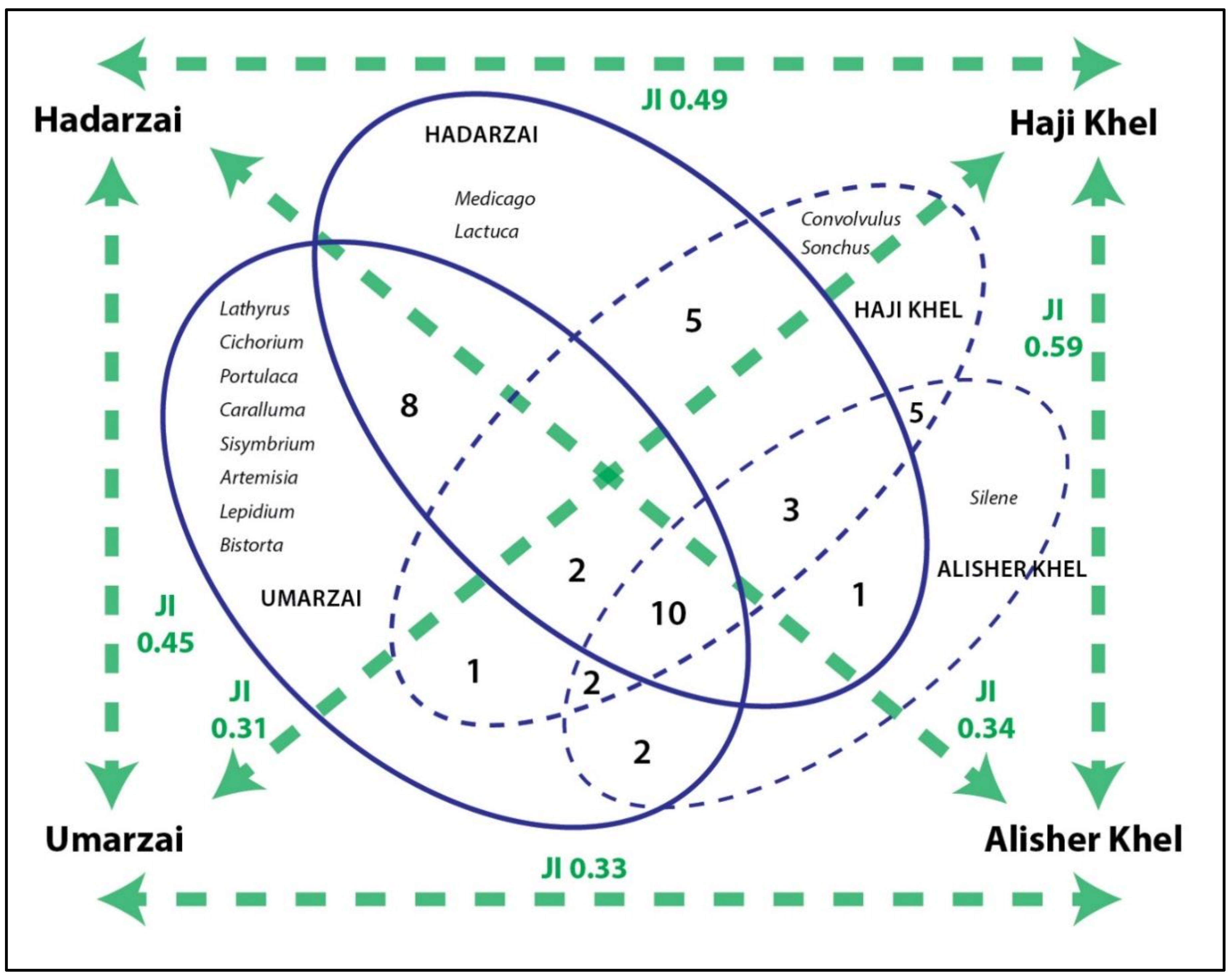
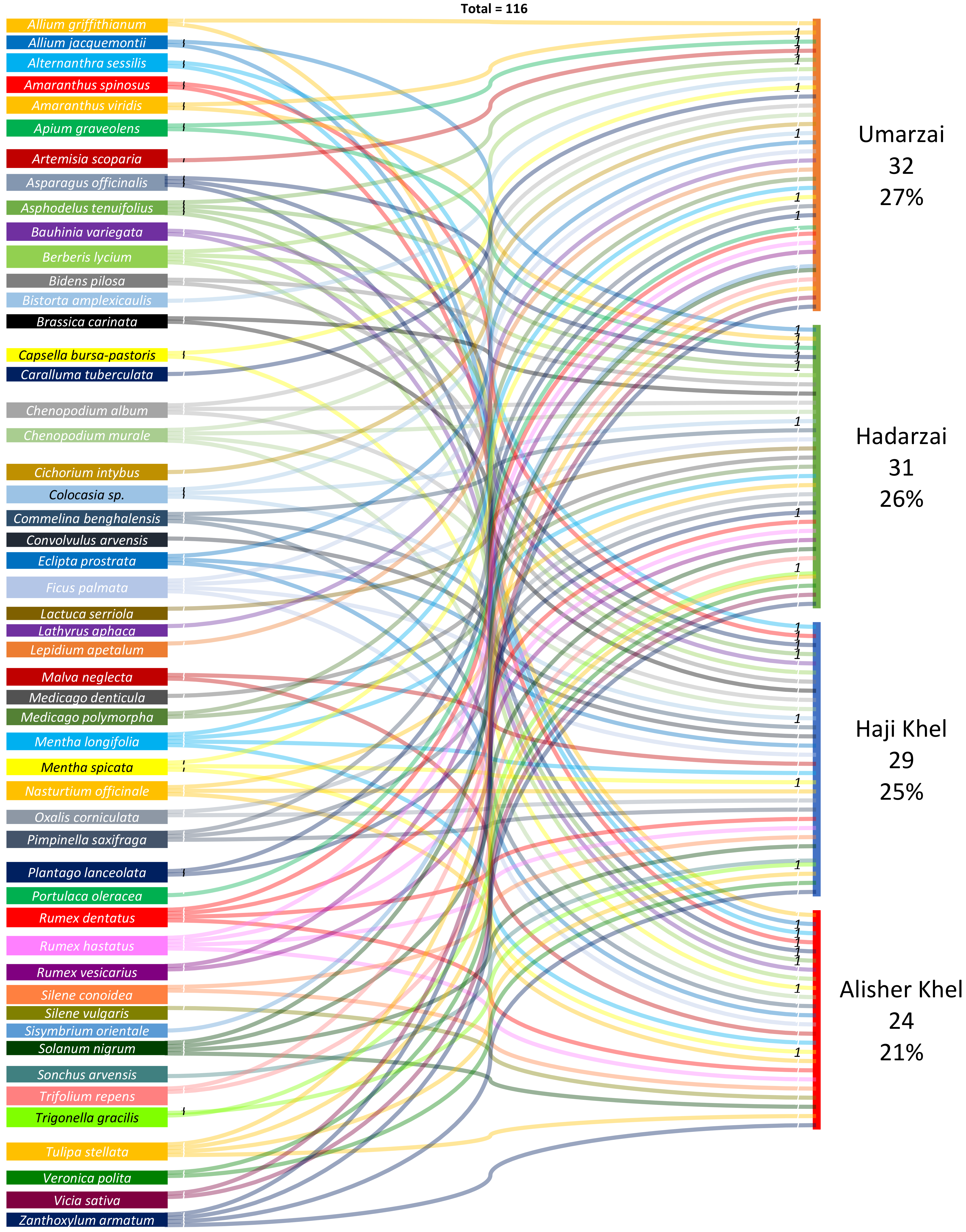
| Parameters | Classes | Frequency of Respondents in Each Class | Percentage |
|---|---|---|---|
| Gender | Male | 88 | 84.62 |
| Female | 16 | 15.38 | |
| Age range | 20–40 years | 19 | 18.26 |
| 40–60 years | 31 | 29.90 | |
| above 60 years | 54 | 51.93 | |
| Educational background | Illiterate | 47 | 45.19 |
| Elementary | 29 | 27.88 | |
| Intermediate | 17 | 16.35 | |
| Graduate | 9 | 8.66 | |
| Post-graduate | 2 | 1.92 | |
| Occupation | Plant collectors | 39 | 37.5 |
| Farmers | 29 | 27.89 | |
| Local sellers | 12 | 11.54 | |
| Housewives | 16 | 15.38 | |
| Shopkeepers | 8 | 7.69 |
| Tribe | Number of Villages | Average Elevation (Feet) and Ecology | Intermarriages | Population | Main Occupation | Interviewed Study Participants | |
|---|---|---|---|---|---|---|---|
| Umarzai | 30 | 5134.5, mountainous area | Intermarriages with Haji Khel and Alisher Khel | 47,025 | Farmers, shepherds | 23 males | 3 females |
| Hadarzai | 17 | 1486.2, both mountain and plain areas | Marriages within the tribe only | 31,900 | Shopkeepers | 22 males | 4 females |
| Haji Khel | 23 | 1561.7, plain area | Intermarriages with Umarzai and Alisher Khel | 46,015 | Laborers, local sellers | 21 males | 5 females |
| Alisher Khel | 15 | 3477.7, both mountain and plain areas | Intermarriages with Haji Khel | 15,296 | Collectors, farmers | 22 males | 4 females |
| Species Number | Plant Species or Taxon, Botanical Family, and Voucher Code | Local Name | Used by Tribal Groups | Parts Used | Habit | Price/kg in Local Markets (USD) | Perceived Medicinal Properties | Local Food Preparation | UR | mCI | Food Uses Previously Reported in KP, Pakistan | |||
|---|---|---|---|---|---|---|---|---|---|---|---|---|---|---|
| UZ | HZ | HK | AK | |||||||||||
| 1. | Allium griffithianum Boiss.; Alliaceae; B.She.150.UOP | Zangali pyaz | + | - | - | + | Whole Plant | Herb | - | None | Cooked, seasoning | - | - | [11] |
| 2. | Allium jacquemontii Kunth; Alliaceae; B.She.151.UOP | Sor pyaz | - | + | - | + | Leaves | Herb | - | None | Cooked, seasoning | - | - | No |
| 3. | Alternanthera sessilis (L.) R.Br. ex DC.; Malvaceae; B.She.152.UOP | Soba | - | - | + | + | Leaves, shoots | Herb | - | Hepatitis, hair tonic | Cooked | 30 | 0.385 | [10] |
| 4. | Amaranthus spinosus L.; Amaranthaceae; B.She.153.UOP | Ganhar | - | - | + | + | Leaves | Herb | - | Diarrhea, wounds | Cooked | 70 | 0.673 | [9,24] |
| 5. | Amaranthus viridis L.; Amaranthaceae; B.She.154.UOP | Senglai | + | + | - | - | Leaves | Herb | - | Laxative | Cooked | 73 | 0.702 | [9,10,11,48] |
| 6. | Apium graveolens L.; Apiaceae; B.She.155.UOP | Danai | + | + | - | - | Leaves and shoots | Herb | - | None | Salad, seasoning, and cooked | - | - | [24,48] |
| 7. | Artemisia scoparia Waldst & Kitam.; Asteraceae; B.She.156.UOP | Jukay | + | - | - | - | Stem, leaves and shoots | Herb | - | Jaundice and hepatitis | Salad | 19 | 0.244 | [10] |
| 8. | Asparagus officinalis L.; Asparagaceae; B.She.157.UOP | Saboon botai | - | + | + | + | Stem | Herb | - | Constipation | Cooked | 37 | 0.475 | [11] |
| 9. | Asphodelus tenuifolius Cav.; Asphodelaceae; B.She.158.UOP | Ogakai | + | + | + | + | Leaves | Herb | - | Diuretic, ulcers | Cooked | 51 | 0.654 | No |
| 10. | Bauhinia variegata L.; Fabaceae; B.She.159.UOP | Kulyar | - | - | + | + | Flowers | Tree | $0.94 | Thyroid hormone-regulating activity | Cooked | 93 | 0.894 | [9] |
| 11. | Berberis lycium Royle.; Berberidaceae; B.She.160.UOP | Karoskai | + | + | + | + | Leaves and fruit, shoots | Shrub | $1.88 | Diabetes, bone fractures | Cooked | 79 | 0.76 | [12] |
| 12. | Bidens pilosa L.; Asteraceae; B.She.161.UOP | Sormal | - | + | + | - | Leaves | Herb | - | Leprosy and skin cuts | Cooked | 7 | 0.27 | No |
| 13. | Bistorta amplexicaulis (D. Don) Greene; Polygonaceae; B.She.162.UOP | Gule rana | + | - | - | - | Leaves and roots | Herb | - | Dysentery | Cooked | 12 | 0.231 | [11] |
| 14. | Brassica carinata (Braun) O.E Schulz; Brassicaceae; B.She.163.UOP | Ghat, sharsham | - | + | + | - | Leaves | Herb | - | Menstrual disorder | Cooked | 6 | 0.231 | No |
| 15. | Capsella bursa-pastoris (L.). Medik.; Brassicaceae; B.She.164.UOP | Badshah | + | - | - | + | Leaves | Herb | - | Diarrhea, bladder infections | Salad, cooked | 21 | 0.270 | [48] |
| 16. | Caralluma tuberculata N.E.Br.; Apocynaceae; B.She.165.UOP | Pamankai | + | - | - | - | Whole plant | Herb | - | Diabetes mellitus | Salad | 9 | 0.116 | [9,11,24,48] |
| 17. | Chenopodium album L.; Amaranthaceae; B.She.166.UOP | Sarmai | + | + | + | - | Shoots and leaves | Herb | - | Urinary tract infections | Cooked | 40 | 0.385 | [9,10,11,12,48] |
| 18. | Chenopodium murale L.; Amaranthaceae; B.She.167.UOP | Thor sarmai | + | + | + | + | Leaves | Herb | - | Anthelmintic | Cooked | 29 | 0.373 | [9,10] |
| 19. | Cichorium intybus L.; Asteraceae; B.She.168.UOP | Shinkai | + | - | - | - | Leaves | Herb | - | Gastrointestinal ailments | Cooked, salad | 31 | 0.596 | [9] |
| 20. | Colocasia sp.; Araceae; B.She.169.UOP | Narai kachaloo | + | + | + | - | Leaves and fruit | Herb | $0.63 | Diarrhea | Cooked and salad | 97 | 0.692 | No |
| 21. | Commelina benghalensis L.; Commelinaceae; B.She.170.UOP | Nari | - | + | + | + | Leaves | Herb | - | None | Cooked | - | - | [11] |
| 22. | Convolvulus arvensis L.; Convolvulaceae; B.She.171.UOP | Pervati | - | - | + | - | Leaves and shoots | Herb | - | Constipation and remove dandruff | Cooked | 13 | 0.311 | [11] |
| 23. | Eclipta prostrata (L.) L.; Asteraceae; B.She.172.UOP | Bandakai | + | - | + | + | Leaves and shoots | Herb | - | Liver tonic | Cooked | 27 | 0.347 | No |
| 24. | Ficus palmata Forsskal.; Moraceae; B.She.173.UOP | Enzar | + | + | + | + | Leaves and shoots | Tree | - | None | Cooked | - | - | [24] |
| 25. | Lactuca serriola L.; Asteraceae; B.She.174.UOP | Kokara | - | + | - | - | Leaves | Herb | - | None | Cooked | - | - | No |
| 26. | Lathyrus aphaca L.; Fabaceae; B.She.175.UOP | Zyar mattar | + | - | - | - | Leaves and fruit | Herb | - | None | Cooked | - | - | [9.11] |
| 27. | Lepidium apetalum Willd.; Brassicaceae; B.She.176.UOP | Bashkai | + | - | - | - | Leaves | Herb | - | None | Cooked | - | - | [9] |
| 28. | Malva neglecta Wallr.; Malvaceae; B.She.177.UOP | Panerak | - | - | + | + | Leaves | Herb | - | Urinary tract infections | Cooked, salad | 46 | 0.442 | [11] |
| 29. | Medicago denticulata Willd.; Fabaceae; B.She.178.UOP | Lewani | - | + | - | - | Leaves | Herb | - | Dysentery | Cooked | 13 | 0.250 | No |
| 30. | Medicago polymorpha L.; Fabaceae; B.She.179.UOP | Shpaishtai | + | + | - | - | Leaves | Herb | - | None | Cooked | - | - | [9,10,11] |
| 31. | Mentha longifolia (L.) L.; Lamiaceae; B.She.180.UOP | Velanai | + | + | + | + | Leaves | Herb | $0.31 | Diarrhea | Salad, cooked | 81 | 0.79 | [9,10,11,12,48] |
| 32. | Mentha spicata L.; Lamiaceae; B.She.181.UOP | Podina | + | - | + | + | Leaves | Herb | $0.44 | Stomach ache, intestinal pains | Salad | 90 | 0.865 | [11,48] |
| 33. | Nasturtium officinale R.Br.; Brassicaceae; B.She.182.UOP | Tarabera | - | + | + | + | Leaves and stem | Herb | - | Urinary tract infections | Cooked, salad | 69 | 0.664 | [9,10,11,12] |
| 34. | Oxalis corniculata L.; Oxalidaceae; B.She.183.UOP | Tarokai | - | + | + | - | Leaves, stem | Herb | - | Vomiting | Salad | 52 | 0.500 | [10,11,24,48] |
| 35. | Pimpinella saxifraga L.; Apiaceae; B.She.184.UOP | Ogai | + | + | - | - | Leaves | Herb | - | Indigestion | Cooked | 5 | 0.193 | No |
| 36. | Plantago lanceolata L.; Plantaginaceae; B.She.185.UOP | Isphagol | + | + | - | - | Stem, leaves | Herb | - | Skin irritations | Cooked | 42 | 0.404 | [11] |
| 37. | Portulaca oleracea L.; Portulacaceae; B.She.186.UOP | Orkharai | + | - | - | - | Shoots | Herb | - | Antiseptic | Cooked | 59 | 0.567 | [11] |
| 38. | Rumex dentatus L.; Polygonaceae; B.She.187.UOP | Shalkhai | + | + | + | + | Leaves | Herb | $0.63 | Kidney stones | Cooked | 70 | 0.898 | [9,10,11,12] |
| 39. | Rumex hastatus D. Don.; Polygonaceae; B.She.188.UOP | Narai shalkhai | + | + | + | + | Leaves | Herb | - | Kidney stones | Cooked | 37 | 0.596 | [9,12] |
| 40. | Rumex vesicarius L.; Polygonaceae; B.She.189.UOP | Ghat tarokai | + | + | - | - | Leaves | Herb | - | None | Salad | - | - | [48] |
| 41. | Silene conoidea L.; Caryophyllaceae; B.She.190.UOP | Mangotai | - | - | + | + | Fruit and leaves | Herb | - | Anemia | Cooked | 13 | 0.168 | [9,10,11] |
| 42. | Silene vulgaris (Moench) Garcke; Caryophyllaceae; B.She.191.UOP | Sor mangotai | - | - | - | + | Leaves and shoots | Herb | - | Constipation | Salad, cooked | 21 | 0.283 | No |
| 43. | Sisymbrium orientale L.; Brassicaceae; B.She.192.UOP | Orai | + | - | - | - | Leaves | Herb | - | None | Eaten raw as a snack | - | - | No |
| 44. | Solanum nigrum L.; Solanaceae; B.She.193.UOP | Kachmacho | + | + | + | + | Whole | Herb | - | Laxative, appetite stimulant | Cooked | 73 | 0.702 | No |
| 45. | Sonchus arvensis L.; Asteraceae; B.She.194.UOP | Zyar gulai | - | - | + | - | Leaves | Herb | - | Asthma, chest pain | Boiled or variously cooked | 18 | 0.232 | [48] |
| 46. | Trifolium repens L.; Fabaceae; B.She.195.UOP | Shutal | + | + | - | - | Leaves | Herb | - | Cough, fever | Cooked, salad | 5 | 0.193 | [11] |
| 47. | Trigonella gracilis Benth.; Fabaceae; B.She.196.UOP | Zyar shpaishtai | - | + | + | - | Leaves | Herb | - | None | Cooked | - | - | [9] |
| 48. | Tulipa stellata Hook.; Liliaceae; B.She.197.UOP | Ghantol | + | + | + | + | Fruit | Herb | - | Antiseptic, sinus pain | Cooked | 11 | 0.142 | No |
| 49. | Veronica polita Fr.; Plantaginaceae; B.She.198.UOP | Angrara | - | + | + | - | Leaves | Herb | - | None | Cooked | - | - | No |
| 50. | Vicia sativa L.; Fabaceae; B.She.199.UOP | Cheelo | + | + | - | - | Leaves and fruit | Herb | - | None | Eaten raw as a snack, salad | - | - | [48] |
| 51. | Zanthoxylum armatum DC.; Rutaceae; B.She.200.UOP | Dambara | + | + | + | + | Fruit | Tree | $2.50 | Asthma, bronchitis | Seasoning | 75 | 0.721 | No |
| S. No. | Species Name | Jan | Feb | Mar | Apr | May | Jun | Jul | Aug | Sep | Oct | Nov | Dec | Avail * |
|---|---|---|---|---|---|---|---|---|---|---|---|---|---|---|
| 1. | Allium griffithianum | 4 | ||||||||||||
| 2. | Allium jacquemontii | 2 | ||||||||||||
| 3. | Alternanthra sessilis | 7 | ||||||||||||
| 4. | Amaranthus spinosus | 8 | ||||||||||||
| 5. | Amaranthus viridis | 8 | ||||||||||||
| 6. | Apium graveolens | 6 | ||||||||||||
| 7. | Artemisia scoparia | 5 | ||||||||||||
| 8. | Asparagus officinalis | 4 | ||||||||||||
| 9. | Asphodelus tenuifolius | 3 | ||||||||||||
| 10. | Bauhinia variegate | 3 | ||||||||||||
| 11. | Berberis lycium | 3 | ||||||||||||
| 12. | Bidens pilosa | 8 | ||||||||||||
| 13. | Bistorta amplexicaulis | 4 | ||||||||||||
| 14. | Brassica carinata | 2 | ||||||||||||
| 15. | Capsella bursa-pastoris | 3 | ||||||||||||
| 16. | Caralluma tuberculata | 8 | ||||||||||||
| 17. | Chenopodium album | 4 | ||||||||||||
| 18. | Chenopodium murale | 8 | ||||||||||||
| 19. | Cichorium intybus | 7 | ||||||||||||
| 20. | Colocasia spp. | 4 | ||||||||||||
| 21. | Commelina benghalensis | 3 | ||||||||||||
| 22. | Convolvulus arvensis | 4 | ||||||||||||
| 23. | Eclipta prostrata | 3 | ||||||||||||
| 24. | Ficus palmata | 7 | ||||||||||||
| 25. | Lactuca serriola | 3 | ||||||||||||
| 26. | Lathyrus aphaca | 3 | ||||||||||||
| 27. | Lepidium apetalum | 4 | ||||||||||||
| 28. | Malva neglecta | 8 | ||||||||||||
| 29. | Medicago denticulata | 4 | ||||||||||||
| 30. | Medicago polymorpha | 6 | ||||||||||||
| 31. | Mentha longifolia | 8 | ||||||||||||
| 32. | Mentha spicata | 8 | ||||||||||||
| 33. | Nasturtium officinale | 8 | ||||||||||||
| 34. | Oxalis corniculata | 8 | ||||||||||||
| 35. | Pimpinella saxifraga | 2 | ||||||||||||
| 36. | Plantago lanceolata | 4 | ||||||||||||
| 37. | Portulaca oleracea | 4 | ||||||||||||
| 38. | Rumex dentatus | 8 | ||||||||||||
| 39. | Rumex hastatus | 8 | ||||||||||||
| 40. | Rumex vesicarius | 6 | ||||||||||||
| 41. | Silene conoidea | 4 | ||||||||||||
| 42. | Silene vulgaris | 4 | ||||||||||||
| 43. | Sisymbrium orientale | 4 | ||||||||||||
| 44. | Solanum nigrum | 6 | ||||||||||||
| 45. | Sonchus arvensis | 4 | ||||||||||||
| 46. | Trifolium repens | 4 | ||||||||||||
| 47. | Trigonella gracilis | 4 | ||||||||||||
| 48. | Tulipa stellata | 4 | ||||||||||||
| 49. | Veronica polita | 8 | ||||||||||||
| 50. | Vicia sativa | 3 | ||||||||||||
| 51. | Zanthoxylum armatum | 2 |
Publisher’s Note: MDPI stays neutral with regard to jurisdictional claims in published maps and institutional affiliations. |
© 2021 by the authors. Licensee MDPI, Basel, Switzerland. This article is an open access article distributed under the terms and conditions of the Creative Commons Attribution (CC BY) license (https://creativecommons.org/licenses/by/4.0/).
Share and Cite
Khan, S.; Hussain, W.; Sulaiman; Shah, S.; Hussain, H.; Altyar, A.E.; Ashour, M.L.; Pieroni, A. Overcoming Tribal Boundaries: The Biocultural Heritage of Foraging and Cooking Wild Vegetables among Four Pathan Groups in the Gadoon Valley, NW Pakistan. Biology 2021, 10, 537. https://doi.org/10.3390/biology10060537
Khan S, Hussain W, Sulaiman, Shah S, Hussain H, Altyar AE, Ashour ML, Pieroni A. Overcoming Tribal Boundaries: The Biocultural Heritage of Foraging and Cooking Wild Vegetables among Four Pathan Groups in the Gadoon Valley, NW Pakistan. Biology. 2021; 10(6):537. https://doi.org/10.3390/biology10060537
Chicago/Turabian StyleKhan, Sheharyar, Wahid Hussain, Sulaiman, Sikandar Shah, Hidayat Hussain, Ahmed E. Altyar, Mohamed L. Ashour, and Andrea Pieroni. 2021. "Overcoming Tribal Boundaries: The Biocultural Heritage of Foraging and Cooking Wild Vegetables among Four Pathan Groups in the Gadoon Valley, NW Pakistan" Biology 10, no. 6: 537. https://doi.org/10.3390/biology10060537
APA StyleKhan, S., Hussain, W., Sulaiman, Shah, S., Hussain, H., Altyar, A. E., Ashour, M. L., & Pieroni, A. (2021). Overcoming Tribal Boundaries: The Biocultural Heritage of Foraging and Cooking Wild Vegetables among Four Pathan Groups in the Gadoon Valley, NW Pakistan. Biology, 10(6), 537. https://doi.org/10.3390/biology10060537













